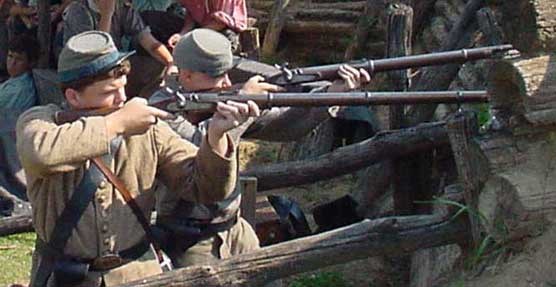
NPS Photo
British Pattern 1853 Enfield Rifle-Musket General Information/Background The P53 Enfield Rifle-Musket was the standard British Infantry weapon from 1853-1867, originally produced at the Royal Arms Factory at Enfield, England. A Confederate Ordnance officer, J.W. Mallet, recalled that "in the early part of the war" Confederate infantrymen were armed with "Springfield and Enfield muskets, Mississippi and Maynard Rifles, Hall’s and Sharp’s carbines, and arms of English, German, Austrian, and Belgian manufacture, of many different calibers." 
The P53 Enfield Rifle-Musket was used by both the North and the South, and merits the distinction of being the second most widely used infantry weapon (surpassed only by the Springfield) in the Civil War. The Confederacy imported more Enfields during the course of the war than any other small arm. Although the British government would not sell weapons to either side, private contractors who produced the British-made firearm, would later sell the Rifle-Musket to the Northern or Southern armies. It has been estimated that over 900,000 P53 Enfields were imported to America and saw service in every major battle from Shiloh in April, 1862, through Vicksburg in 1863, to the final battles of 1865. The P53 Enfield weighed about 9 lbs and was approximately 53" in length. The bore was .577 caliber, to which a 16" bayonet could be afixed.

Small arms ammunition was normally stored in the soldier’s cartridge box, with a normal issue being approximately 40 rounds. The ammunition was a paper-wrapped cylinder which held the ball and powder. The cartridge was tied and glued to prevent spillage of the powder. Normally cartridges were packaged in groups of 10, wrapped in paper, with 12 or 13 percussion caps, and issued to the soldier. The soldier would have to tear open the cartridge using his teeth, pour the powder down the muzzle, remove the ball from the paper and then place the ball in the muzzle pushing it down the barrel with a ramrod. 
The principal means of ignition in firing Civil War small arms was by using a percussion cap. The percussion cap looked like a tiny "top hat" or cap, thus the name. The cap was made of copper, slightly conical, with a rim or flange at the open end. The interior of the percussion cap had a small quantity of fulminate of mercury (waterproofed by coating it with shellac varnish) which would cause the percussion cap to explode when struck with a sharp blow. The percussion cap would be placed on the cone at the breech (back) end of the gun. When the trigger was pulled, the hammer would strike the percussion cap causing a flame to go through the cone and ignite the powder in the barrel, shooting the ball out the muzzle of the gun.
Firing the Rifle-Musket The National Park Service (NPS) has modified the original Civil War Small Arms Drill, designed as a battle drill to fire the rifle-musket under combat conditions. Although the soldier’s safety was paramount, speed was essential. Since combat is not an issue in Civil War parks today, the National Park Service has altered the drill to enhance the safety of the demonstrator. 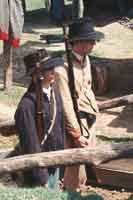
NPS Photo Load in Nine Times 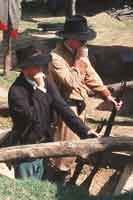
NPS Photo A cartridge is taken from the cartridge box and brought up to the mouth. TEAR CARTRIDGE Using the teeth, the paper cartridge is torn, exposing the powder. 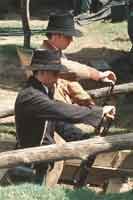
NPS Photo After tearing open the cartridge, the cartridge is brought next to the muzzle of the weapon, and at this command all the powder is poured down the barrel, and the ball placed in the muzzle. The paper follows on top of the ball. (Note - Live ammunition is not used in NPS weapons demonstrations — only powder and paper commonly referred to as a blank charge.) 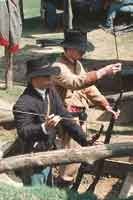
NPS Photo The ramrod is removed from the pipes and held, waiting for the next command. RAM CARTRIDGE The rammer is inserted into the muzzle and the cartridge pressed home. The rammer is then removed and placed back into the pipes. RETURN RAMMER The rammer is returned to its fully seated position. 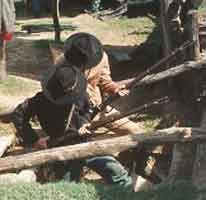
NPS Photo PRIME 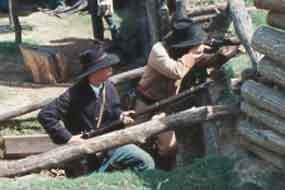
NPS Photo Using the right thumb, the weapon is fully cocked. 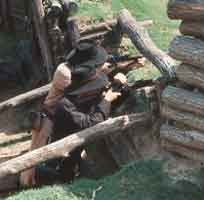
NPS Photo The butt of the weapon is brought to the shoulder, taking aim on the target. FIRE The forefinger is pressed against the trigger, firing the weapon.
After the weapon was discharged the soldiers would wait for the command, "RECOVER ARMS," and bring the weapon off the shoulder to either reload or cease firing. The above procedures would be used under the best of circumstances. A soldier on the drill field would be expected to load and fire a musket 3-4 times per minute. In combat, it was much different. |
Last updated: April 14, 2015
